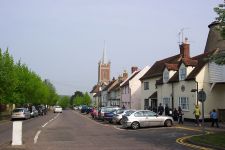Bishop's Stortford is a historic market town in Hertfordshire, England, just west of the M11 motorway on the county boundary with Essex, 27 miles (43 km) north-east of central London, and 35 miles (56 km) by rail from Liverpool Street station. Bishop's Stortford had an estimated population of 40,815 in 2019.
History
Nothing is known of Bishop's Stortford until it became a small Roman settlement on Stane Street, the Roman road linking Braughing and Colchester. The settlement was probably abandoned in the 5th century after the break-up of the Roman Empire.
A new Saxon settlement grew up on the site, named Steort-ford, the ford at the tongue of land. In 1060, William, Bishop of London, bought Stortford manor and estate for £8, leading to the town's modern name. At the time of the Domesday Book the village had a population of around 120. The Normans built a wooden motte-and-bailey edifice known as Waytemore Castle (see below).
Only the baptismal font survives from the Norman Church of St Michael, which was rebuilt in the early 15th century and altered and restored in the 17th and 19th centuries. Its conspicuous belfry and spire were built in 1812.
Despite outbreaks of the plague in the 16th and 17th centuries, the town continued to grow, reaching a population of about 1,200.
The River Stort is named after the town, and not the town after the river. When cartographers visited the town in the 16th century, they reasoned that the town must have been named after the ford over the river and assumed the river was called the Stort.
After 1769, the River Stort was made navigable, and the town became a stop on the mail coach road between Cambridge and London.
By 1801, Bishop's Stortford was a market town, and a corn exchange had been established, while the main industry was malting. In 1842 the railway came to Bishop's Stortford. Another Victorian advance was the opening of a hospital in 1895.
In 1901 the population exceeded 7,000. The 1901 house
